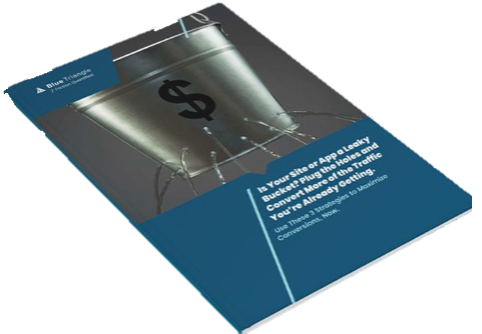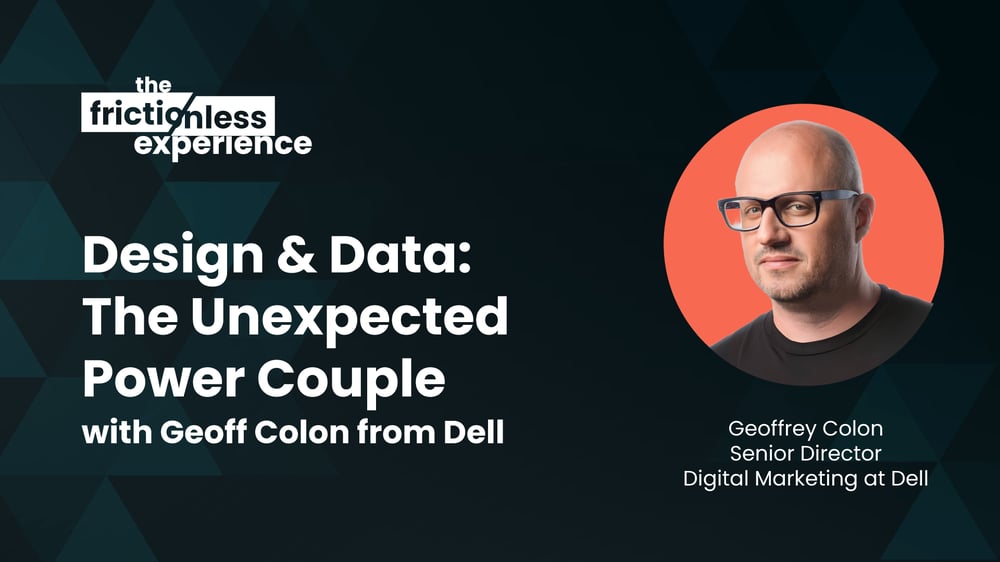To drive a better digital experience for your customers, stop imitating and start innovating
Imitation is the sincerest form of flattery, right?
Not when it leads to herd mentality in digital experiences, where everyone is imitating what they see other companies do in a futile copycat exercise.
Instead of delivering a memorable and distinctive brand experience, consumers end up awash in a sea of digital sameness.
It's a topic Geoff Colon, Senior Director of Digital Marketing at Dell, explored on a recent episode of The Frictionless Experience podcast.
Check out Geoff Colon on The Frictionless Experience by clicking the image above or by visiting here.
"I mean, if we look at all the different designs out there, all of them look similar," Jeff says. "I haven't used an app in a really long time that I've said, wow, the design of this is light years different from everything else, because everyone wants to start from the same place."
And yet, consumers often still experience frustrating friction when completing digital transactions.
Why?
Because just copying what you see on another brand's site or app fails to consider the critical underpinnings necessary to deliver a smooth, seamless experience for your unique customers.
Visit The Frictionless Experience YouTube Channel here for more videos.
So why do brands choose to copy competitors instead of innovating?
We discussed two possible contributors to sameness:
1. Leaders sometimes inadvertently recruit teams without enough diversity of thought, instead cloning a team's best contributors with others who think the same way.
Having a diverse team with varied ways of thinking leads to more creative and interesting solutions, which Jeff notes is crucial for creating standout customer experiences.
2. Teams too often obsess over benchmarking and comparing their site's performance with competitors.
Comparing your site to your competitors overlooks the fact that different brands, even in the same industry, attract unique audiences.
While there may be some overlap, copying leads to prioritizing the same customers you directly compete for while overlooking the customers who prefer your brand over your competitor and for whom you have the opportunity to deliver uniquely enjoyable experiences.
Ultimately, you should strive to create the best, friction-free experience for your unique users.
Companies that focus on creating enjoyable experiences without just simply copying others' strategies are likely to succeed and draw in more customers, as people are motivated by good experiences.
Designing Innovative, Frictionless Experiences for Your Customers
Not sure how to start?
Consider these three strategies:
1. Understand and design for your customer's entire journey, including after the initial purchase.
Geoff has led product teams for both B2C and B2B audiences. In his experience, companies that have transitioned from B2C to B2B, such as IBM, must adapt their design strategies accordingly.
Even companies primarily identified as B2C may actually operate as B2B, Geoff notes citing his previous stint at Microsoft.
Designing for B2B often involves similar considerations as designing for B2C, such as understanding the visitor, their communication needs, and their objectives on the site.
Geoff suggests that websites should focus on first inspiring and educating customers and then guiding them toward a purchase decision and post-purchase follow-up. It's crucial to collect real customer feedback to inform future customers and provide objective solutions.
Companies often make the mistake of bombarding visitors with information about themselves instead of focusing on solving the customer's problem and providing solutions.
The customer journey, especially in B2B, is akin to matchmaking, where inspiration and problem-solving precede learning about the company and its solutions.
Companies can use design not only to attract but also to retain customers, track their needs, and provide personalized recommendations based on their purchase history, creating a cycle of reciprocity.
This approach, which Geoff spoke of as the nudge philosophy, involves nudging customers towards related products or services based on their previous purchases.
2. Use Analytics to Drive Innovation, Not Just Incrementally Improve Experiences.
Using analytics to guide digital experiences based solely on current data will result in consistently similar outcomes.
Geoff notes, "What I'm starting to see more of is companies who are just literally copying rather than transforming and combining into a new experience."
Visit The Frictionless Experience YouTube Channel here for more videos.
To create meaningful change, analytics should be used to understand the data from visitors and then take action to steer the experience in a new direction.
Instead of simply optimizing for the status quo, actionable insights involve using data to drive changes and improvements in the digital experience.
"The only time I ever see marketers make big moves is when those numbers are really bad," Geoff adds. "Oh, whoa, we're getting like zero percent of people who are staying on here."
So instead of making big moves only when confronted with bad numbers, marketers need to seek creative solutions that consider whether the right audience is being attracted and their needs are being met.
Brands should focus on attracting the right people by being transparent about their offerings and employing analytics to shape the future instead of just optimizing current experiences.
3. Create frictionless experiences designed for the way humans operate.
When designing an experience, consider human behavior and anticipate potential unexpected scenarios to ensure a positive outcome.
"I think sometimes we only want visitors to go this direction. And it's like, have you met human beings?" Geoff says with a laugh.
"That's not how most of us behave. I like to cause trouble, just to cause trouble. I'm always the one in the room saying, what if people do this? And they're like, but they won't do that, Geoff. And I'm like, no, they will!"
Teams should design for exceptions and anticipate potential unintended friction that could be created—for example, a new feature that designers think will improve user experience but slows down the site or prevents items from being added to the cart—to deliver a consistently delightful experience that builds customer trust and loyalty.
And that includes understanding how different audiences may take different paths.
In an earlier episode of The Frictionless Experience featuring Mike Shady, former Senior Vice President of Online for Lowe's, he noted that the experience and needs of the "Pros" (e.g., builders, contractors) vary greatly from the home DIY'er.
"Both Home Depot and Lowe's have Pro versions of their websites, tailored to what they need," Mike notes. "Think of the things like building decks," Mike gives an example:
"I know that I need X many boards, X many nails, this many cans of stain. That order becomes something that you can reorder and use (with every project). You know what the pricing looks like, you're not even looking items up, most of the time you have those things saved off, or you're using like the model number to be able to (order) it."
He contrasts this journey to a consumer ordering an appliance and coordinating delivery and pick up of the old appliance, plus the supplies needed to install it, such as hoses for a washer.
Every business must clearly understand the unique needs of every type of customer and build unique journeys that remove the friction common to each transaction being completed.
Rather than focusing on what's easier for you, consider what the best experiences are for your customers.
Instead of settling for good enough, be bold, take calculated chances, and explore beyond your comfort zone to push the boundaries of the experiences you provide your customers.
In the end, Geoff and others note it's about more than just providing the best experience possible in your line of business or industry.
Visit The Frictionless Experience YouTube Channel here for more videos.
Customers are not only comparing your brand's experience against your direct competitors but also against the best digital experience they've ever experienced.
Smart brands combine analytics and creativity to remove friction and transform ideas into new, user-centric experiences that differentiate their brand and, as a result, drive more revenue.
How can brands design innovative frictionless experiences for customers?
- Understand and design for your customer's entire journey, including after the initial purchase or transaction.
- Use analytics to drive meaningful innovation and not just what you think the experience should be.
- Create frictionless experiences designed for the way humans actually operate.
.png)
During the holiday rush, every shopper matters
Optimize the customer journey before the eCommerce event of the year.

.jpg)


